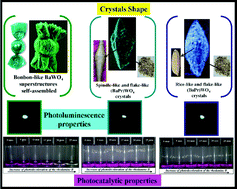Barium praseodymium tungstate (Ba1-xPr2x/3)WO4 crystals with (x = 0, 0.01, and 0.02) were prepared by the coprecipitation method. These crystals were structurally characterized by X-ray diffraction (XRD), Rietveld refinements, Fourier-transform Raman (FT-Raman) and Fourier-transform infrared (FT-IR) spectroscopies. The shape and size of these crystals were observed by field emission scanning electron microcopy (FE-SEM). Their optical properties were investigated by ultraviolet visible (UV-vis) absorption and photoluminescence (PL) measurements. Moreover, we have studied the photocatalytic (PC) activity of crystals for degradation of rhodamine B (RhB) dye. XRD patterns, Rietveld refinements data, FT-Raman and FT-IR spectroscopies indicate that all crystals exhibit a tetragonal structure without deleterious phases. FT-Raman spectra exhibited 13 Raman-active modes in a range from 50 to 1000 cm−1, while FT-IR spectra have 8 infrared active modes in a range from 200 to 1050 cm−1. FE-SEM images showed different shapes (bonbon-, spindle-, rice- and flake-like) as well as a reduction in the crystal size with an increase in Pr3+ ions. A possible growth process was proposed for these crystals. UV-vis absorption measurements revealed a decrease in optical band gap values with an increase of Pr3+ into the matrix. An intense green PL emission was noted for (Ba1-xPr2x/3)WO4 crystals (x = 0), while crystals with (x = 0.01 and 0.02) produced a reduction in the wide band PL emission and the narrow band PL emission which is related to f–f transitions from Pr3+ ions. High photocatalytic efficiency was verified for the bonbon-like BaWO4 crystals as a catalyst in the degradation of the RhB dye after 25 min under UV-light. Finally, we discuss possible mechanisms for PL and PC properties of these crystals.

You have access to this article
 Please wait while we load your content...
Something went wrong. Try again?
Please wait while we load your content...
Something went wrong. Try again?


 Please wait while we load your content...
Please wait while we load your content...